When it comes to 9mm carry pistols, there are several characteristics that immediately come to mind. Polymer frame, striker fired, wide grips, and high capacity. Recently we found three, or should we say three and a half pistols, that didn’t quite fit that description.
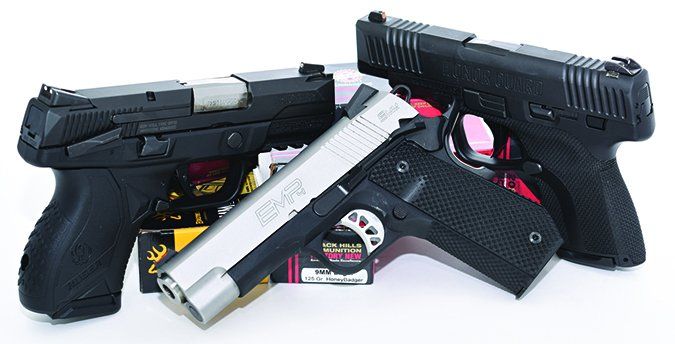
The first was Ruger’s $579 American Compact model 8633 that featured thumb-operated safeties on both sides.
Next were products from Honor Defense, one of the newer makers on the market. The $499 Honor Guard HG9CLE is a single-stack double-action-only pistol. The LE suffix stands for law enforcement. This gun was a variation on the original Honor Defense pistol, but it lacks a Picatinny accessory rail to favor inside-the-waistband carry for undercover work. Our 3.8-inch-long-barreled Compact LE pistol arrived with a second top end ($250, sold separately) that housed a 3.2-inch-long barrel. The shared receiver boasted unique grip contours, and both top ends utilized the same guide rod and recoil spring.
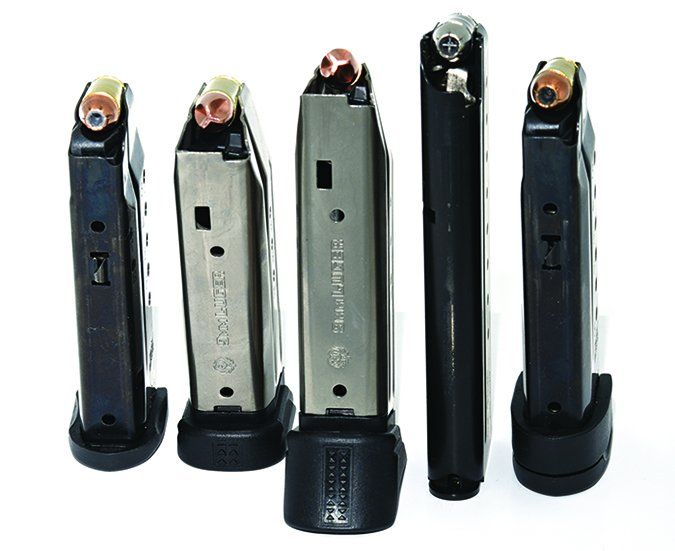
Third was the $1220 Springfield Armory 1911 EMP 4-inch Conceal Carry Contour pistol, which arrived with three 9-round magazines. The EMP operates with a single-action trigger, and this might have been our first test wherein a single-stack 1911 pistol packed more rounds than its polymer-framed competitors. Its descriptive name referred to the gun’s backstrap, which has been sliced diagonally, making the rear of the grip about of an inch shorter than if it were continued in a straight line to the heel of the magazine well. This made the pistol more concealable, specifically when holstered with a butt forward (or muzzle back) cant.
Our test sessions began and ended on the reactive targets located on Steel Alley at American Shooting Centers in Houston. Accuracy data was collected from a distance of 15 yards with the guns supported by a Caldwell Matrix rest. Our choice of test ammunition consisted of Browning’s new 147-grain BXP X-point jacketed hollowpoints and three different rounds from Black Hills Ammunition of Rapid City, South Dakota. They were the 115-grain JHP EXPs that were designed for maximum performance in guns not rated for +P ammunition, a 124-grain JHP +P choice, and a new subsonic round, the 125-grain non-expanding HoneyBadger ammunition. We tracked the velocity of each combination using an Oehler 35P (printing) chronograph.
All three guns were recent releases, so we really didn’t know what to expect. As always our goal was to reveal reliability and accuracy as well as handling characteristics. Would we find versatility or would the accuracy of each gun be limited to a single bullet weight? Our job was to deliver to point of aim every time we pulled the trigger. Would any of these guns make that job easier than the others? Here is what we learned.
Range Data
| Black Hills Ammunition 115-gr. JHP EXP | Springfield Armory EMP 19229L | Ruger American Compact 8633 | Honor Defense HG9CLE/HG99SC |
| Average velocity | 1218 fps | 1226 fps | 1240 fps/1180 fps |
| Muzzle energy | 379 ft.-lbs. | 384 ft.-lbs. | 393 ft.-lbs./355 ft.-lbs. |
| Average group | 1.3 in. | 1.3 in. | 2 in./2 in. |
| Black Hills Ammunition 124-gr. JHP +P | |||
| Average velocity | 1205 fps | 1117 fps | 1176 fps/1051 fps |
| Muzzle energy | 400 ft.-lbs. | 343 ft.-lbs. | 381 ft.-lbs./304 ft.-lbs. |
| Average group | 1.5 in. | 1.9 in. | 2.5 in./2.6 in. |
| Black Hills Ammunition 125-gr. HoneyBadger | |||
| Average velocity | 975 fps | 993 fps | N/A |
| Muzzle energy | 264 ft.-lbs. | 274 ft.-lbs. | N/A |
| Average group | 1 in. | 1.5 in. | N/A |
| Browning Ammunition 147-gr. BXP X-point | |||
| Average velocity | 972 fps | 947 fps | 993 fps/901 fps |
| Muzzle energy | 308 ft.-lbs. | 322 ft.-lbs. | 622 ft.-lbs./265 ft.-lbs. |
| Average group | 0.9 in. | 1.6 in. | 2.75 in./3.6 in. |
| To collect accuracy data, we fired five-shot groups from a Caldwell Matrix rest. Distance: 15 yards. We recorded velocities using an Oehler 35P chronograph, with the first sky screen set 10 feet from the muzzle. | |||
Ruger American Compact 8633 9mm Luger, $579
GUN TESTS GRADE: D-
The RAP Compact is an ideal size for concealed carry. With thumb safeties in place, the trigger could be shorter and lighter. We could not complete our tests without reseating the recoil assembly multiple times.
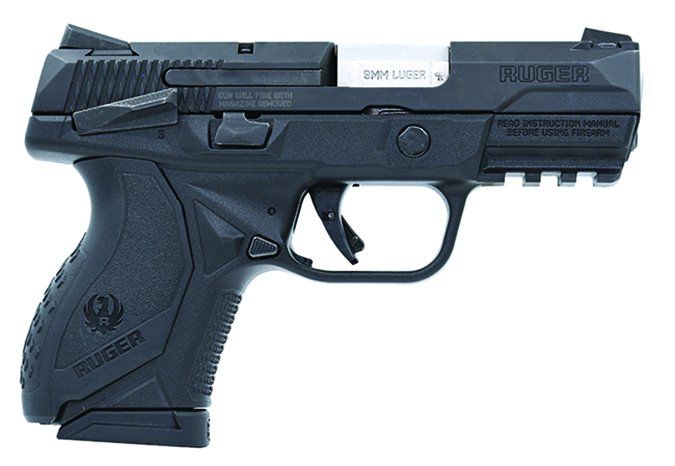
| ACTION | Double action; striker fired |
| OVERALL LENGTH | 6.65 in. |
| OVERALL HEIGHT | 4.48 in. |
| MAX WIDTH | 1.51 in. |
| WEIGHT UNLOADED | 25.9 oz. |
| WEIGHT LOADED | 34 oz. |
| BARREL LENGTH | 3.55 in. |
| BARREL | Steel |
| MAGAZINE | 10 rds., staggered column |
| SLIDE | Black nitride, stainless steel |
| FRAME | Glass-filled nylon |
| FRONT STRAP HEIGHT | 2.4 in./2.9 in. |
| BACK STRAP HEIGHT | 2.9 in. |
| GRIP | Glass-filled nylon |
| GRIP THICKNESS (max) | 1.25 in. |
| GRIP CIRCUMFERENCE | 5.3 in./5.6 in. |
| SIGHT RADIUS | 5.8 in. |
| TRIGGER PULL WEIGHT (DA) | 9 lbs. |
| TRIGGER SPAN (DA) | 2.6 in. |
| WARRANTY | N/A |
| TELEPHONE | (770) 432-1202 |
| WEBSITE | Ruger.com |
| MADE IN | USA |
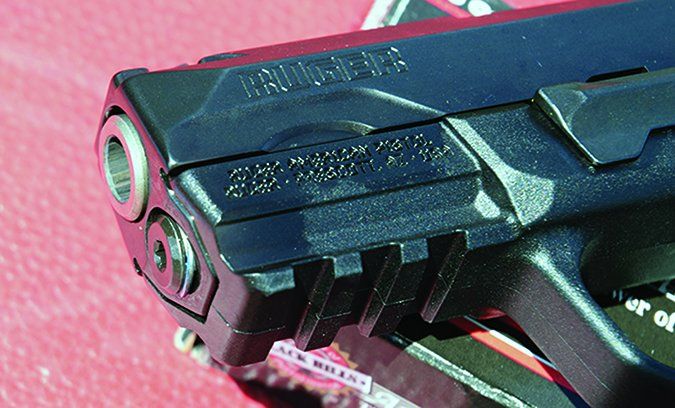
There are 16 different models listed under Ruger’s “American Pistol” lineup chambered for either 9mm Luger or 45 ACP, but when you look at the main spec sheet at Ruger.com, the handguns fall into two categories: Pro Model and Manual Safety. The ambidextrous manual safety levers on our pistol added about 0.11 inches in width when compared to the Pro Model. Ambidextrous safeties are rarely found on striker-fired pistols, and when they are on such guns, they simply turn off the trigger. In the case of the RAP they also prevented the slide from moving. Maximum capacity of the 45 ACP pistols was 11 rounds (10+1), but the 9mm RAPs carry either 10-round or 17-round magazines. The longest barrel lengths in this series measure 4.5 inches long but are limited to the forty-fives. The larger 9mm pistols shoot from a 4.2-inch-long barrel, but the barrel in our compact model was much shorter, measuring 3.55 inches in length.
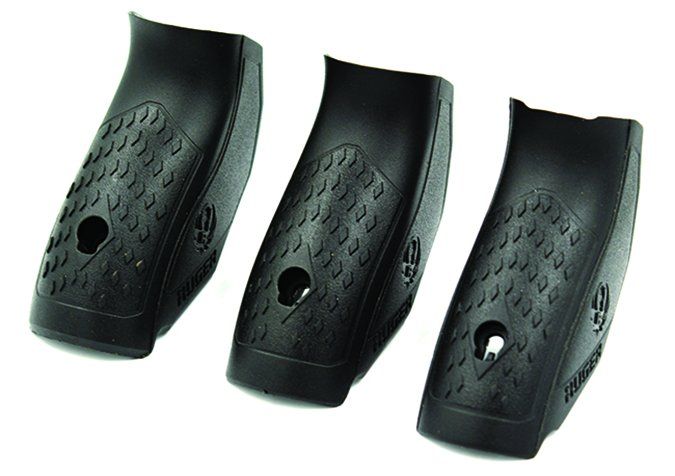
Taking it from the top, the RAP Compact offered Novak’s snag-resistant sights enhanced with three white dots. A relief in the barrel hood was available for visual chamber loaded/unloaded confirmation. Grip serrations found on the rearward portion of the slide were only interrupted on the right-hand side by an externally mounted extractor of impressive size. The complete top end was easily removed by locking back the slide and rotating the takedown lever located on the left-hand side of the frame clockwise about 45 degrees. This is much like SIG Sauer’s design and also the Springfield Armory XD/XDM pistols of Croatian origin. The recoil assembly was a two-piece design working off two captured springs.
The Ruger American series are striker-fired pistols with a Glock-style safety lever located in the face of the trigger. In addition, the operator could release the magazine from either side, and there was a three-slot accessory rail ahead of the trigger guard. The grip was steeply undercut, creating a beavertail to assist in recoil control. Three different size and contour backstraps were supplied to accommodate different hands. Two of the backstraps measured the same in terms of circumference, but one had less palm swell, making up the distance in width, side to side. The backstraps were held in place by a Torx-type screw that only needed a quarter turn to set and release a cam-style lock. If you misread this subtle movement or mistook the camming screw for one that needs to be completely removed, you will shear off the wrench tip. Don’t ask how we know this. While our shooters defaulted to the smallest of the backstraps, no one was uncomfortable with any of the supplied backstraps.
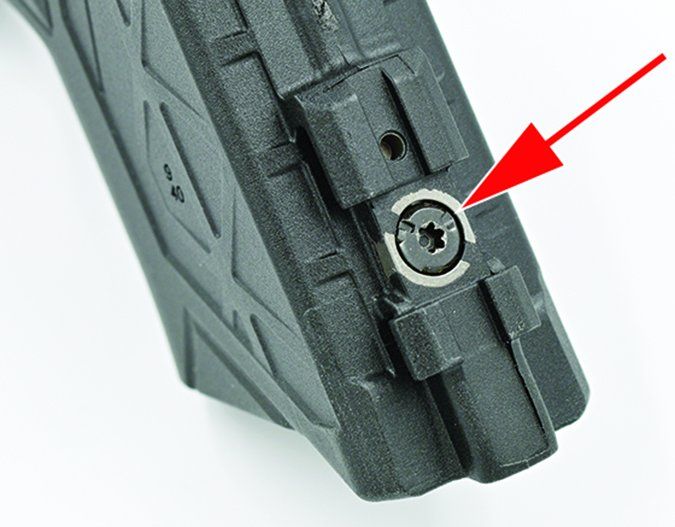
Two 10-round magazines were supplied, each with a pinky ledge that worked to complete the grip profile. A flat basepad was also supplied; it did not limit capacity, but did make the Ruger easier to conceal. We think only larger hands will prefer the larger basepads.
At the range, our first offhand session was punctuated by case ejection into the shooter’s face. While ejectors can be manually tuned, the problem did abate, perhaps due to break-in speeding up the slide action or perhaps wear to the ejector itself. From the bench, we were hunkered down behind the sights so that ejection was primarily over the shooter’s right-hand shoulder. Trigger-pull weight measured about 9.0 pounds on average. Offhand accuracy required steering the front sight to the center over the duration of a half-inch-long trigger pull that felt slow and cumbersome.
From the bench, the RAP Compact showed a distinct preference for all 115-grain ammunition, but most notably the Black Hills 115-grain JHP EXP rounds. The next best choice in combination with this pistol was the subsonic 125-grain HoneyBadger ammunition. But during our tests, we had a breakdown that could have been catastrophic. We noticed that the slide was not going fully forward, but the gun would still fire. As soon as we realized this we stopped the session to investigate. This was dangerous, because if the gun is capable of firing even slightly out of battery, the cartridge case was not being fully encapsulated by the chamber. The resulting lack of support could have resulted in case rupture, pushing out debris and propellant through the space between the chamber mouth and the breech face.
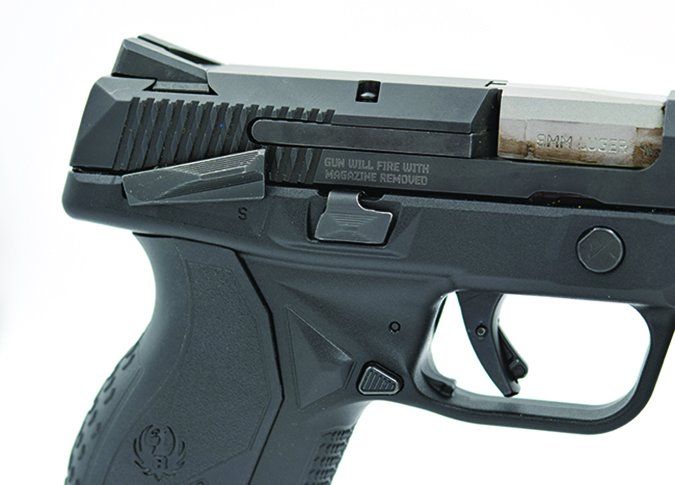
Our first telltale sign was the rear of the slide sitting slightly ajar. We also noticed that the first coil on the primary recoil spring was slipping through the yoke at the front of slide. We reseated the recoil spring and were able to continue our tests. When this happened a second time, we questioned the ability of the yoke to secure the front of the recoil spring. We also noticed that the rear of the recoil assembly was riding up and not seating properly against the barrel lug. We completed our tests, but we had to remove the top end and reseat the recoil assembly multiple times. However, during our final offhand session, we recognized that the gun was not going to maintain battery and retired the pistol.
Our Team Said: We’re not sure why our gun did not always go fully into battery, but we think either the forward recoil spring was not fit properly to the guide rod or the guide rod assembly was a poor fit to the yoke. We liked the ambidextrous safeties. They were properly placed for intuitive access, and they locked down the slide. This means the tactic of pushing off an aggressor with a muzzle strike (a lost art since the demise of the revolver and 1911 in police work) was back in play. We think the Manual Safety RAPs should be called the “Pro” model. But take away bench support, and the RAP Compact was not the easiest gun to shoot accurately off hand. It has a long trigger, and balancing the gun in the hand while steering the sights was where our skill level was tested. We think the long trigger, a safety device in itself, was better suited to the Pro Models. With thumb safeties in place, a long trigger was doubling down unnecessarily, in our view. The magazine release was also quite sticky from either side and needed refinement.
Honor Defense Compact HG9CLE 9mm Luger, $499;
HG9SC Conversion, $250
GUN TESTS GRADE: B+
Admirably fills the role of a highly concealable fighting gun that’s inexpensive and fun to shoot.
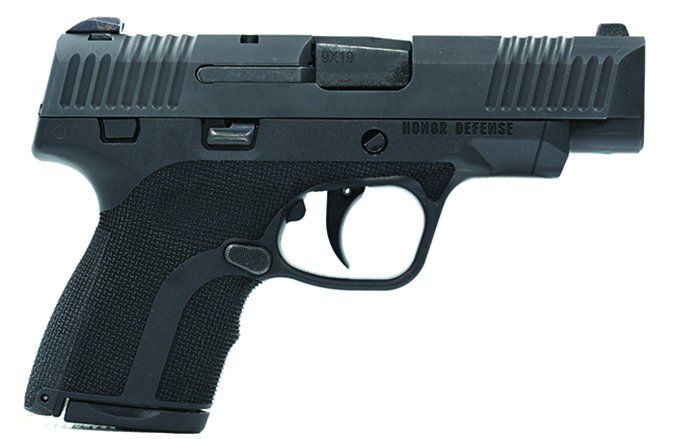
| ACTION | Double action, striker fired |
| OVERALL LENGTH | 6.28 in. |
| OVERALL HEIGHT | 4.6 in. |
| MAX WIDTH | 0.96 in. |
| WEIGHT UNLOADED | 23 oz. |
| WEIGHT LOADED | 29.8 oz. |
| BARREL LENGTH | 3.8 in. |
| BARREL | Steel |
| MAGAZINE | 7 and 8 rds./Single column |
| SLIDE | Stainless steel/ferritic nitrocarburized |
| FRAME | Polymer, stainless steel chassis |
| FRONT STRAP HEIGHT | 1.8 in./2.26 in. |
| BACK STRAP HEIGHT | 2.7 in. |
| GRIP | Polymer |
| GRIP THICKNESS (max) | 0.95 in. |
| GRIP CIRCUMFERENCE | 4.9 in./5.15 in. |
| SIGHT RADIUS | 5.65 in. |
| TRIGGER PULL WEIGHT (DA) | 8.5 lbs. |
| TRIGGER SPAN (DA) | 2.7 in. |
| WARRANTY | Limited 2-year (original owner) |
| TELEPHONE | (678) 943-8035 |
| WEBSITE | HonorDefense.com |
| MADE IN | USA |
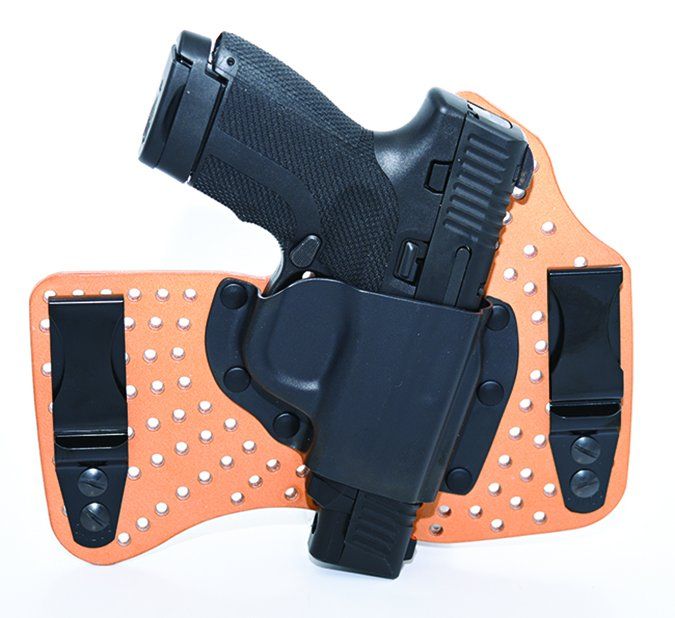
Honor Defense is a Georgia-based manufacturer with fewer than eight different models in production, all of which are chambered for 9mm Luger and designated Honor Guard pistols. The company logo is based on the shoulder patch worn by American soldiers fighting in what has been referred to as “The Forgotten Theatre of World War II.” This refers to action in the China-Burma-India Theatre, including the Himalayas. The patch helped MPs identify American personnel, especially in light of conflicts with British military also serving in the area. All components are manufactured in the United States, and Honor Defense is known for hiring veterans for assembly, test firing, and general input.
The Honor Guard pistols work primarily off one available grip frame or receiver with color options such as Black, Mil-Green and FDE (flat dark earth). All grip frames are cut to accommodate a thumb-operated safety lever but some models like our pistol operated sans safety levers. The series is split between subcompact and Long Slide models meaning mounted with either a 3.8-inch-long barrel and accompanying slide or a top end built around a 3.2-inch-long barrel. Until the release of our LE model all pistols that shipped with long slides featured a grip frame enhanced with a two-slot picatinny rail. The one outlier in the catalog is the Sub-Compact FIST that features the full-length frame fit with the shorter top end. The underlug juts out beneath the barrel and slide offering a spiked frontal surface for defending via a muzzle strike.
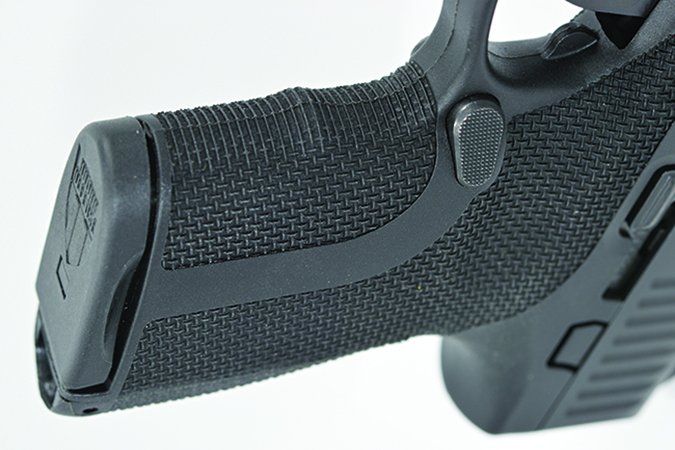
The most eye-catching characteristic of the Honor Defense pistols is the grip frame enhanced with stippling that resembles woven cloth. This texture was very effective and covered the grip frame from the front of the trigger guard to the backstrap. The gun is quite narrow, so it was inherently easy to point. If this mimics the Browning 1911 pistol, the imagery is extended by the choice of two supplied backstraps playing the role of a flat mainspring housing and an arched mainspring housing. Two magazines were supplied, one holding seven rounds with a flat base pad and another holding eight rounds that extended the grip by about a half inch. Low-profile release buttons that energetically released the magazines were located at the lower rear corner of the grips on both sides.
The Honor Defense pistols are striker fired with a locked-breech system that works much like the SIG pistols. And like the Ruger American Compact, the Honor Guard was field-stripped by locking back the slide and rotating a takedown lever. The guide-rod assembly, however, does not capture the forward spring. The top end was fit with snag-resistant sights, offering a red dot on the front sight to be found between two white dots on the rear sight. The rear unit was drift adjustable and anchored by a 0.050 sized Allen wrench. This is one size smaller than typically found in wrench sets. Generous cocking serrations were machined into the slide fore and aft on both the long- and short-slide top ends. This was helpful because the slide latch was flush fit to enhance its snag-free profile, making it necessary to pull back the slide to send it into battery.
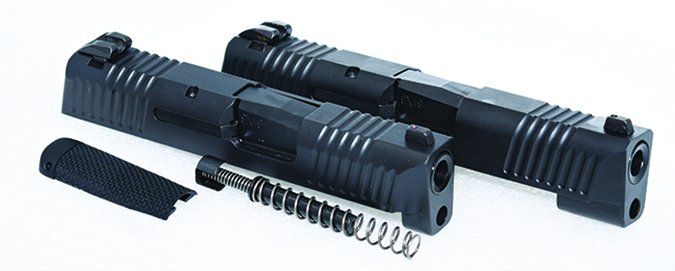
In comparing the Honor Defense receiver with the short and long slide top ends, our accuracy results were remarkably similar. While there was a significant drop in velocity from the longer barrel (about 92 fps on average for all shots fired), it was difficult to tell which groups were fired with which top end. From the bench, each combination was capable of delivering 2.0-inch groups when firing the Black Hills 115-grain JHP EXP rounds. Likewise, most groups measured about 2.5 inches across when loaded with the 124-grain JHP +P rounds. The 3.8-inch barrel liked the 147-grain Browning BXP ammunition just fine (2.75-inch groups on average), but we’d not choose them for the shorter barrel because the resulting groups were nearly 1-inch wider across. The most accurate rounds (Black Hills 115-grain JHP EXP) lost only 60 fps when switching from the 3.8-inch barrel to the 3.2-inch-long barrel. The 124-grain +P rounds lost the most (125 fps on average). Our only failure in the test was finding out that the subsonic HoneyBadger rounds would not cycle fully into the chamber. We think that since the primary recoil spring was not captured, the Honor Guard was open to experimenting with different-weight springs that might offer greater slide travel and/or more time for the rounds to feed into the chamber.
Firing carefully from the bench, we did find a minor rough spot in the trigger that seemed to improve with use, leading us to believe this could be refined with polishing. Working on the Honor Guard pistols or changing to a different-color grip frame, for that matter, was simple because the chassis that contains the frame rails and firing system can be easily removed just by rotating out the takedown lever. In the meantime, Honor Defense recommends lubrication at points of interaction along the trigger bar. Fired standing offhand, the ergonomics of the narrow pistol with its grippy texture helped us stabilize the sights while pressing the trigger. Another plus was the relatively short distance the trigger needed to travel to reach the point of ignition.
Our Team Said: We think the Honor Guard bridges the gap between primary carry and backup gun. It does hide well, and without the accessory rail, the gun makes for comfortable carry. If the “Long Slide” model is a good pistol, it is a little down on rounds compared with other guns approximately the same size. With the short top end in place for deeper concealment, its capacity was, in our view, more forgiving. And giving up one round to make the gun even smaller didn’t bother us because controllability was excellent. A formidable foe from either combination, we liked the way the Honor Guard popped into our hands and cycled quickly, making it fun to shoot.
Springfield Armory 1911 EMP 4-Inch Conceal Carry Contour PI9229L 9mm Luger, $1220
GUN TESTS GRADE: A
The EMP delivered accuracy and ergonomics on par with more expensive custom guns and simply outclassed the other pistols.
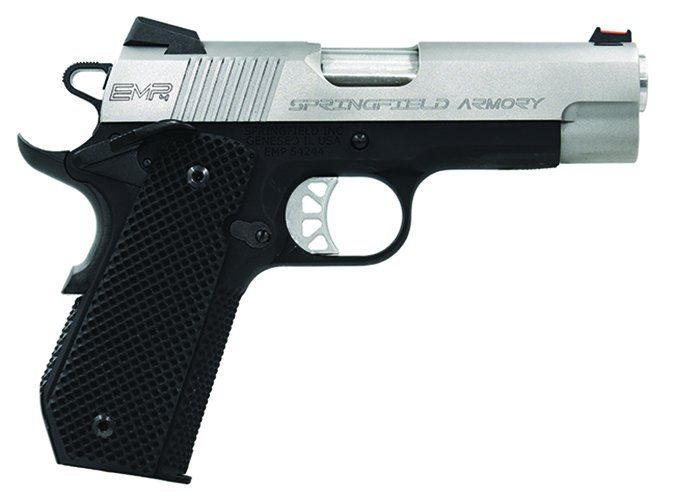
| ACTION | Single action, hammer fired |
| OVERALL LENGTH | 7.5 in. |
| OVERALL HEIGHT | 5.5 in. |
| MAX WIDTH | 1.4 in. |
| WEIGHT UNLOADED | 28 oz. |
| WEIGHT LOADED | 35.3 oz. |
| BARREL LENGTH | 4 in. |
| BARREL | Steel |
| MAGAZINE | 8 rds., single column |
| SLIDE | Stainless steel, satin finish |
| FRAME | Anodized aluminum alloy |
| FRONT STRAP HEIGHT | 2.6 in. |
| BACK STRAP HEIGHT | 2.4 in. |
| GRIP | Polymer |
| GRIP THICKNESS (max) | 1.14 in. |
| GRIP CIRCUMFERENCE | 5 in. |
| SIGHT RADIUS | 5.5 in. |
| TRIGGER PULL WEIGHT (SA) | 5.5 lbs. |
| TRIGGER SPAN (SA) | 2.7 in. |
| WARRANTY | Limited lifetime, original owner |
| TELEPHONE | (800) 680-6866 |
| WEBSITE | Springfield-Armory.com |
| MADE IN | USA |
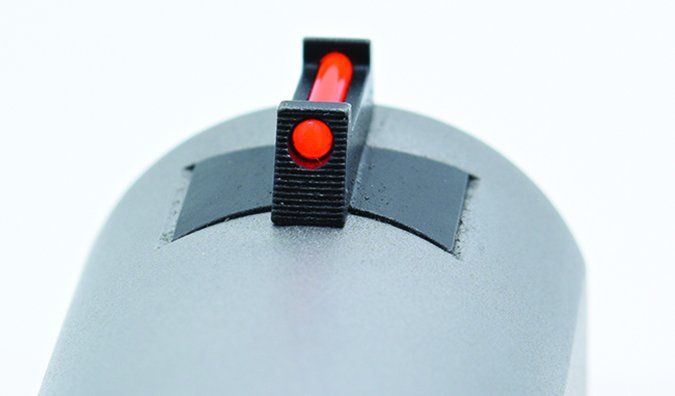
The original EMP pistol from Springfield Armory was a smaller pistol competing with the Kimber Micro 9 and others like it. A likable pistol, it could be seen as a variation on a 1911 Officer’s model, but it was actually quite heavy for its size. The EMP 4-inch pistol tested here could be defined as a Lightweight 1911 Commander. One key difference would be the traditional Commander-length barrel measures 4.25 inches in length. The receiver or frame compares evenly to the full-size Government model, save for the backstrap, which has been trimmed diagonally at the rear bottom edge. To make this more comfortable, the rear of the grip, including the mainspring housing, has been given a rounded profile just short of a full palm swell. Not everyone’s hand applies pressure to the rear of the grip top to bottom, and the point at which the angle was cut should seat nicely inside the hollow of most shooter’s palms. Holstered with the angle of the bore pointing to approximately 1 o’clock and 7 o’clock (for the right-handed shooter), the highest point on the resulting silhouette would be minimized and blunted, making telltale printing beneath a garment less likely.
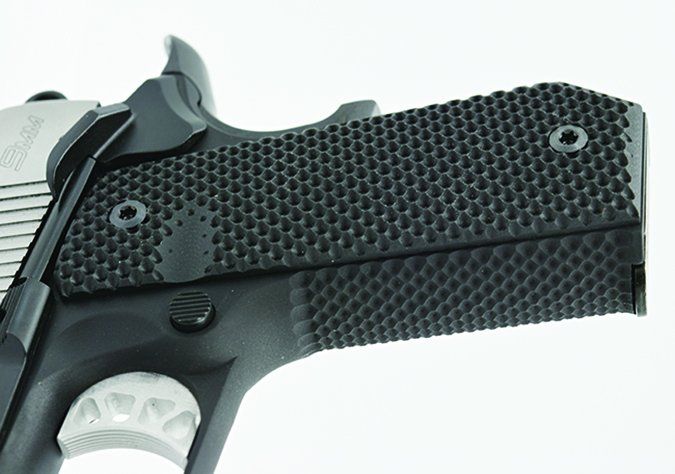
With a suggested retail price more than $1000, the EMP was fit with a number of features that were developed by competitive shooters and would normally be considered custom parts. These features include a Novak snag-resistant rear sight affixed via a wide dovetail cut into the slide. The rear sight was matched with a front sight offering a light-gathering filament that glowed with a red dot in ambient light. We didn’t break the filament, but extra lengths of red and green were provided. The slide was machined from forged stainless steel and finished with a satin texture.
Further custom upgrades included a lowered and flared ejection port, a skeletonized hammer for faster reset, a ventilated aluminum trigger and an oversized beavertail with memory bump. The memory bump is a raised area that assures every palm size will make positive contact and fully compress the grip safety. Thumb-operated safety levers that lock the trigger and seize movement of the slide were mounted on both sides of the forged aluminum alloy frame. The frame was treated to a black hardcoat anodized finish.
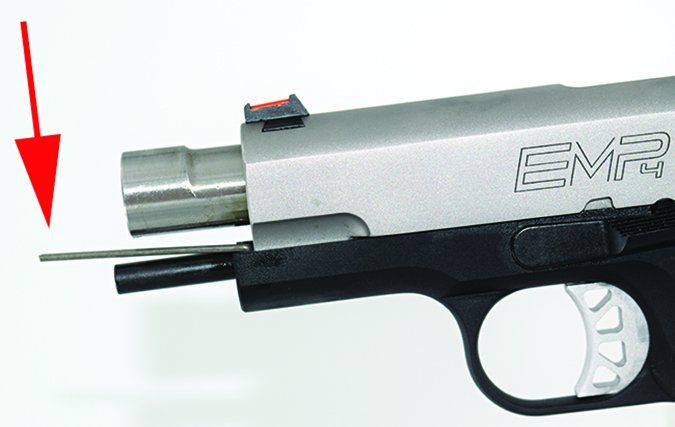
The story of the Springfield Armory EMP is in the grip. Not so much its special contour, but the way the shooter “wears” the pistol in his hand. Whereas just about every polymer pistol maker has been chasing the perfect grip by providing alternate panels that change the impression the gun makes in the shooter’s hand, the 1911 single-stack pistol has never had any such problem. Yes, you can change the side panels from flat to rounded, but the rectangular nature of the 1911 frame with the narrow length facing forward has always made this design easy to hold and point. Once you have a good grip on the EMP, you never have to change it until it’s time to reload. Larger hands may not need to shift the gun at all to drop the magazine.
The chance of the EMP swimming in the hand was further reduced by a dimple-style grip pattern that flowed from the front strap to the side panels to the mainspring housing. Good looking and comfortable the gun stuck like glue in our shooter’s hands without being abrasive. A channel machined into the left side grip panel helped access the left-side-only magazine release button. The thumb safeties were operated easily and the trigger needed only about 5.5 pounds of pressure over 0.07 inches of travel to drop the hammer.
Takedown of the EMP was simple, but did require a tool that could be improvised if it were lost. To remove the EMP’s top end, the gun was emptied and the slide locked fully to the rear. This exposed the front of the bull barrel and the solid guide rod. Finding the small hole in the guide rod, we inserted the supplied “L” shaped takedown rod. (A bent length of wire would also suffice.) This captured the recoil spring, thereby removing pressure from the slide.
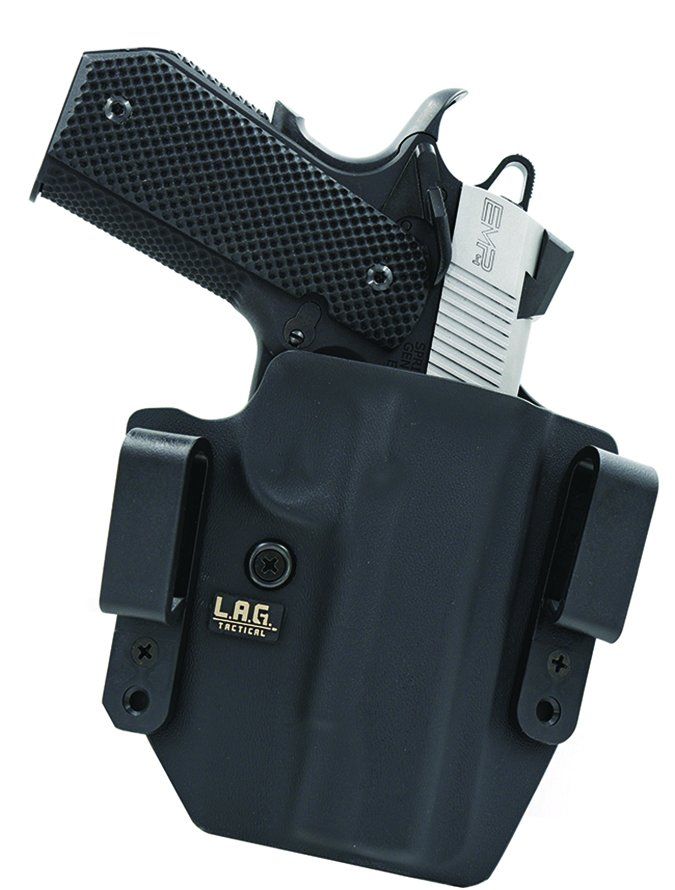
The top end was then released against the take down pin. This automatically aligned the slide-stop lever in line with the takedown notch in the slide. The slide stop can now be removed, freeing the top end from the frame. If there were a tricky part to reassembling the handgun in reverse order, it would be lining up the barrel link, which swings freely so that the slide stop pin can be threaded through to the other side of the frame.
At the range we were reminded why we used the analogy of wearing the EMP rather than merely holding it. From the bench we had a great sense of control. Despite all four rounds being very different in terms of bullet shape, construction, bullet weight, and velocity, we printed five-shot groups that averaged less than 1.2 inches across for all shots fired. The Black Hills HoneyBadger landed 1.0-inch groups and cycled quickly in the EMP, despite its recoil feeling much less than our recorded 975-fps average velocity. The Browning 147-grain BXP X-Point rounds were even better, printing groups that averaged 0.9 inches across.
Our Team Said: The real story behind our accuracy results was we had to work really hard to produce good results with the other pistols. But the EMP was very easy to shoot accurately, and it never failed for a moment.
We think just about any shooter is going to be able to achieve results comparable to ours. One staffer said the gun was so easy to shoot we were getting lazy and probably could have produced tighter groups if we tried harder. While the other guns were challenged by the 15-yard test distance, we’re sure the EMP will be able to keep pace with many more-expensive full-sized 1911s from the 25-yard line.
Written and photographed by Roger Eckstine, using evaluations from Gun Tests team testers.

























